Unit 6 Space and beyond_高二英语外研版(2019)选择性必修第四册教材习题精讲 课件(共32张,内嵌音频)
文档属性
| 名称 | Unit 6 Space and beyond_高二英语外研版(2019)选择性必修第四册教材习题精讲 课件(共32张,内嵌音频) | 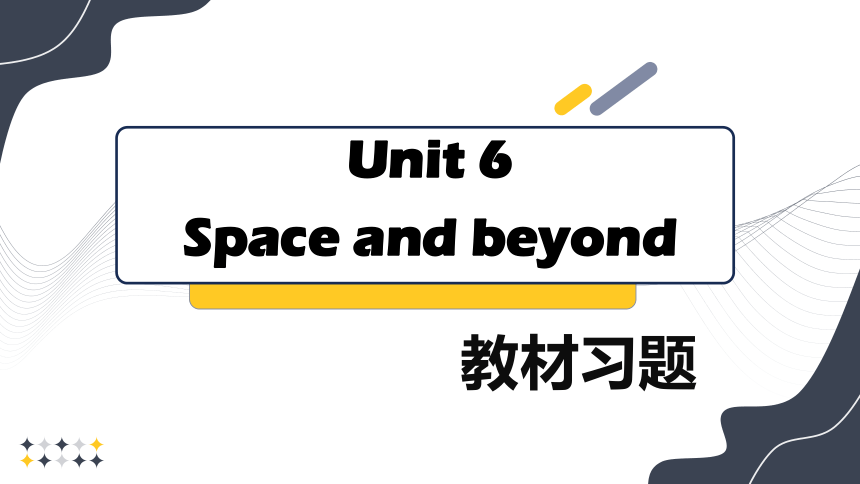 | |
| 格式 | pptx | ||
| 文件大小 | 31.9MB | ||
| 资源类型 | 教案 | ||
| 版本资源 | 外研版(2019) | ||
| 科目 | 英语 | ||
| 更新时间 | 2025-04-21 19:54:44 | ||
图片预览



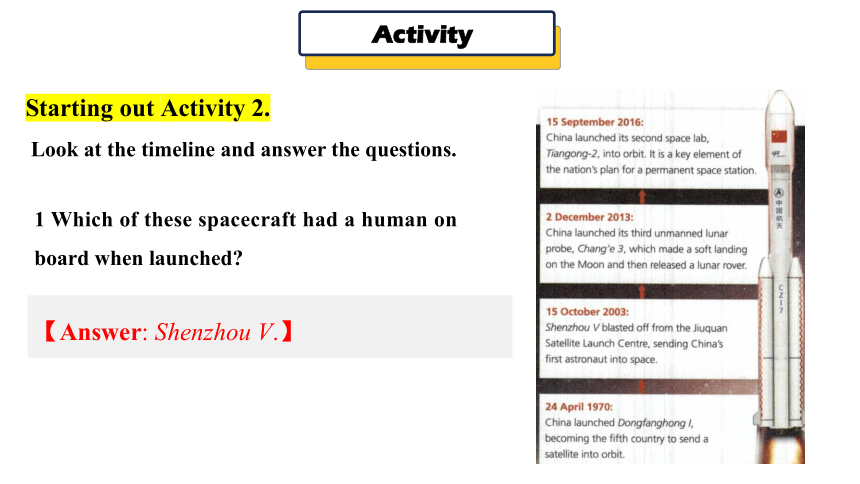
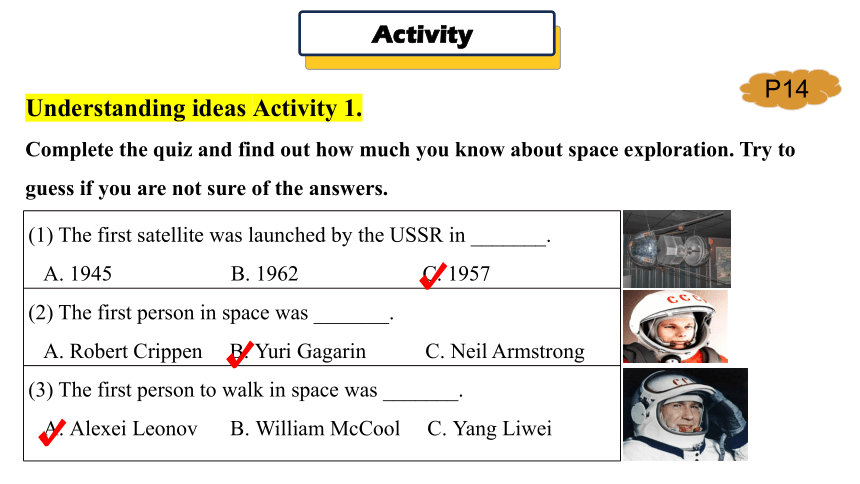

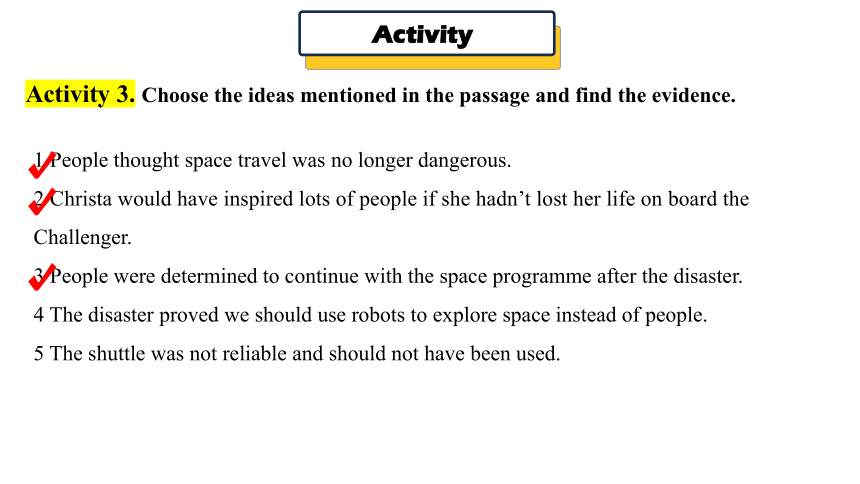

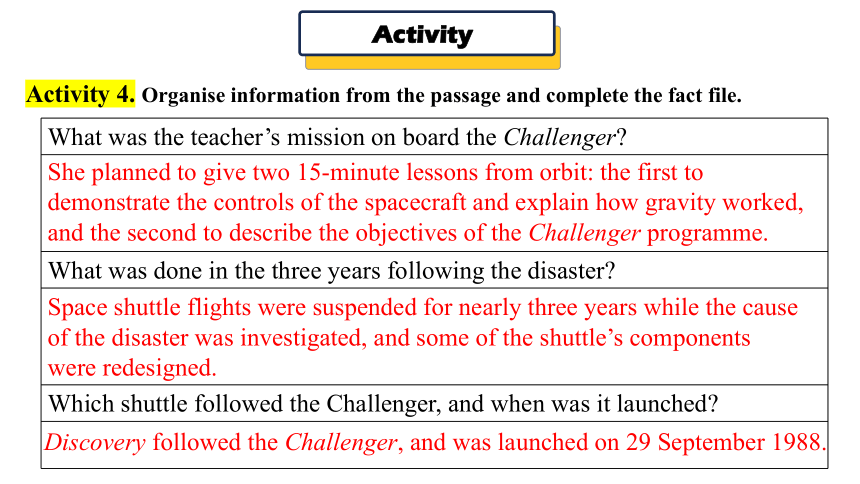
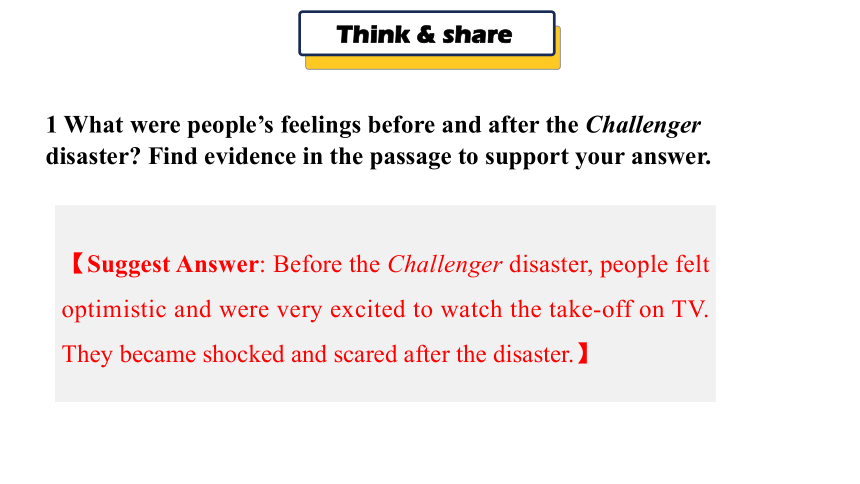

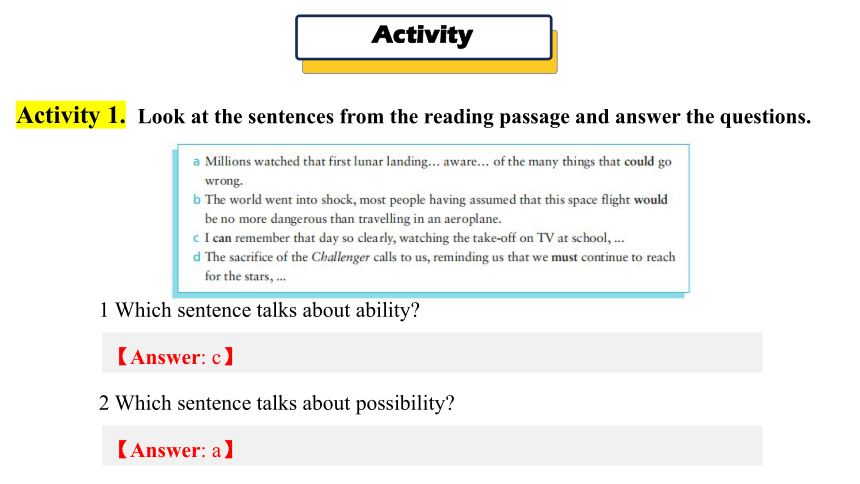
文档简介
教材习题
Unit 6
Space and beyond
01
Understanding ideas
Starting out Activity 1
Watch the video and answer the questions.
Activity
1 How was the Sun formed?
【Suggest Answer: First, enough gas and dust pulled together to make a disc where the planets were formed. Then, building pressure heated up the center of the disc to one million degrees, and a nuclear reaction began, which formed the Sun.】
2 Where are the Asteroid Belt and the Kuiper Belt in the solar system?
【Suggest Answer: The Asteroid Belt lies between Mars and Jupiter. The Kuiper Belt exists just beyond the orbit of Neptune.】
Starting out Activity 2.
Look at the timeline and answer the questions.
Activity
1 Which of these spacecraft had a human on board when launched?
【Answer: Shenzhou V.】
Understanding ideas Activity 1.
Complete the quiz and find out how much you know about space exploration. Try to guess if you are not sure of the answers.
Activity
P14
{5940675A-B579-460E-94D1-54222C63F5DA}(1) The first satellite was launched by the USSR in _______.
A. 1945 B. 1962 C. 1957
(2) The first person in space was _______.
A. Robert Crippen B. Yuri Gagarin C. Neil Armstrong
(3) The first person to walk in space was _______.
A. Alexei Leonov B. William McCool C. Yang Liwei
√
√
√
Understanding ideas Activity 1.
Complete the quiz and find out how much you know about space exploration. Try to guess if you are not sure of the answers.
Activity
P14
{5940675A-B579-460E-94D1-54222C63F5DA}(4) The first space station was Salyut Ⅰ, which was launched by _______.
A. the USA
B. the USSR
C. the European Space Agency
(5) The first spacecraft to leave the solar system was _______.
A. Vostok 1
B. Discovery
C. Voyager 1
√
√
Activity 3. Choose the ideas mentioned in the passage and find the evidence.
Activity
1 People thought space travel was no longer dangerous.
2 Christa would have inspired lots of people if she hadn’t lost her life on board the Challenger.
3 People were determined to continue with the space programme after the disaster.
4 The disaster proved we should use robots to explore space instead of people.
5 The shuttle was not reliable and should not have been used.
√
√
√
Activity 4. Organise information from the passage and complete the fact file.
Activity
{5940675A-B579-460E-94D1-54222C63F5DA}Space Shuttle Challenger
Time
___________________
Place
Space Centre in Florida USA
Crew
_____________, including a teacher
What was special about the Challenger launch?
seven astronauts
28 January 1986
It was special because Christa McAuliffe aged 37, an ordinary teacher and mother, was about to become the first civilian in space.
Activity 4. Organise information from the passage and complete the fact file.
Activity
{5C22544A-7EE6-4342-B048-85BDC9FD1C3A}What was the teacher’s mission on board the Challenger?
What was done in the three years following the disaster?
Which shuttle followed the Challenger, and when was it launched?
She planned to give two 15-minute lessons from orbit: the first to demonstrate the controls of the spacecraft and explain how gravity worked, and the second to describe the objectives of the Challenger programme.
Space shuttle flights were suspended for nearly three years while the cause of the disaster was investigated, and some of the shuttle’s components were redesigned.
Discovery followed the Challenger, and was launched on 29 September 1988.
Think & share
1 What were people’s feelings before and after the Challenger disaster? Find evidence in the passage to support your answer.
【Suggest Answer: Before the Challenger disaster, people felt optimistic and were very excited to watch the take-off on TV. They became shocked and scared after the disaster.】
02
Using language
Activity
【Answer: c】
1 Which sentence talks about ability?
【Answer: a】
2 Which sentence talks about possibility?
Activity 1. Look at the sentences from the reading passage and answer the questions.
Activity
【Answer: d】
3 Which sentence talks about necessity?
【Answer: b】
4 Which sentence talks about prediction?
Activity
On 15 October 1997,the Cassini spacecraft set out on a mission to explore the planet Saturn. So great was the distance from Earth that it would / shall need to travel for almost six years to reach its destination. When it reached Saturn, it sent back amazing images of the planet’s famous rings viewed in ultraviolet light. Cassini made numerous trips around Saturn so it could / must collect data. Over the following years, Cassini took some 450,000 images of the planet and its moons. Finally, on 15 September 2017, Cassini was pointed towards Saturn so that it should / would meet a fiery end. Scientists had decided that Cassini could / must be destroyed this way, so it must / would not collide with any of Saturn’s moons. In its nearly 20-year mission, Cassini provided so much information that scientists could / would not process it all. No wonder so many people took to social media to bid it goodbye, saying, “Farewell, dear Cassini! We shall / should never forget you!”
Activity 2. Read the passage and choose the correct modals.
Activity
Activity 5. Listen to the interview and choose the questions discussed.
1 Is there life on other planets?
2 What would life on other planets look like?
3 Should we use robots to explore space?
4 What is the Fermi Paradox?
5 Will people ever make contact with life on other planets?
√
√
√
Activity
Activity 6. Listen and complete the table.
{5C22544A-7EE6-4342-B048-85BDC9FD1C3A}
Answers
Q1
Sophie: There must be millions of planets like ours, and some could have life 1___________________.
Eric: You would think it likely that 2__________________________________. But that’s 3___________________ the Fermi Paradox.
Q2
Sophie: Life on other planets won’t look like us because 4_______________________________________________________________.
Eric: Because evolution 5____________________________________, life on other planets is likely to look like us.
similar to our own
there are forms of life somewhere
without considering
conditions on other planets won’t be like those on Earth
would work the same way everywhere
Activity
Activity 6. Listen and complete the table.
{5C22544A-7EE6-4342-B048-85BDC9FD1C3A}
Answers
Q3
Eric: We cannot 6_____________________, which means it would take more than a lifetime to reach planets where there might be life.
Sophie: Maybe we don’t need to travel in straight lines. Perhaps we will be able to 7___________________________________________________________ to make contact with life on other planets.
travel faster than light
take short cuts, through a “wormhole” in space, for example
Activity
Activity 7. Complete the boxes with the expressions from the interview.
? I think there definitely is. ? Since..., it isn’t reasonable to...
? There’s evidence that... ? It would be wonderful if...
? The fact that... means... ? Let’s hope that...
Expressing hopes
Expressing opinions
{5940675A-B579-460E-94D1-54222C63F5DA}
{5940675A-B579-460E-94D1-54222C63F5DA}
? I think there definitely is. ? Since..., it isn’t reasonable to...
? There’s evidence that... ? The fact that... means...
? It would be wonderful if... ? Let’s hope that...
Activity
Activity 8. Work in pairs. Read the passage and answer the questions.
The dramatic scientific developments of recent years have brought space exploration back to public attention. As getting into space is however, still not an easy task, more and more space camps and other places are providing simulated space adventures.The Space Camp, founded in 1982 under NASA, is an educational camp, where children can learn about space travel and astronomy, and even have the chance to have lunch with an astronaut! So far, the camp has inspired hundreds of thousands of young people from the US and from elsewhere around the world. What's more, some of its ex-students have even grown up to become astronauts!
【Answer: The passage is mainly about the Space Camp.】
3 What is the passage mainly about?
Activity
Activity 9. Read the advertisement for the space camp and find out what students can do there. Pay attention to the words and expressions in bold.
Sign up for our space programme now and give your knowledge of aviation and space a boost! Here at the observatory, you can learn about astronomy and take in a lunar eclipse.You will also have the chance to design and launch a model rocket.Then, join your mission teammates in our modern flight simulators. Put on a spacesuit, exit the capsule and go on your incredibly lifelike spacewalk in a world with zero gravity. Scared of being space sick? Don't worry! Your special training will take care of this. Make the most of your lunar exploration adventure before re-entering into the atmosphere on your way back to Earth.
Activity
Activity 9. Read the advertisement for the space camp and find out what students can do there. Pay attention to the words and expressions in bold.
At the observatory, you can learn about astronomy and take in a lunar eclipse. You will also have the chance to design and launch a model rocket. Then in modern flight simulators, you could put on a spacesuit, exit the capsule and go on your incredibly lifelike spacewalk in a world with zero gravity.
Activity
Activity 10. Complete the email with the correct form of the words and expressions in Activity 9.
Dear Ted,
Remember when I told you I’d signed up for the space programme? Well I just got back from a week of simulated manned flight activities, and it was awesome!
We started out with some theory, learning about astronomy in the 1___________ and then 2_________ model rockets. After that we tried the simulator. I put on a 3__________ and went for a walk in 4______________________. It’s strange to float around like that - in fact, a lot of people get 5___________! Luckily, I felt fine. Then I returned to the 6__________ and travelled to the “Moon” for some lunar exploration. You should join the programme too - you’d love it!
Write soon!
Yours,
Kim
observatory
launched
spacesuit
a world with zero gravity
space sick
capsule
03
Developing ideas
Activity 1. Match the images taken by the Hubble Space Telescope to their nicknames. Do research online to find out more information about?them.
Activity
a
b
c
? 1 The Pillars of Creation
? 2 The Horsehead
? 3 The Cat’s Eye
b
c
a
Activity 3. Think about how the author organised the passage and complete the timeline with information from the passage.
Activity
Thousands of years ago, people already regarded the night sky as an _________________________. It was believed that the huge eyes of the large-eyed bronze statues from the Chinese archeological site at Sanxingdui were able to ______________________________________________.
Our power to see the sky changed dramatically when _______________________________________. It extended_________________________ and caused us to realise that the universe is a far larger place than we ever imagined.
endless source of fascination
look across great distances into the stars
the first telescope was angled at the night sky
the power of the human eye
Activity 3. Think about how the author organised the passage and complete the timeline with information from the passage.
Activity
In 1990, the hubble Space Telescope was launched into orbit. For the first time, people could________________________________
_________________________________. These ranged from ______________________________________, and even to new planets.
In 2016, __________________was built in China. It is used in the search for dark matter, which cannot be observed by ordinary telescopes. Its ____________ has the ability to make discoveries beyond our imaginations.
see breathtakingly beautiful images of our universe taken from beyond Earth
enormous clouds of gas to huge black holes
the FAST telescope
vast dish
Think & share
3 In what different ways do the two reading passages in this unit reflect the spirit of?exploration?
【Answer:?The first passage is about the Challenger disaster. Although it was a tragedy, people did not stop exploring space. This shows that people will always seek to explore, even if some lose their lives in doing so. The second passage is about the development of the telescope, and how it reflects our desire to explore the unknown. Unlike the exploration conducted by astronauts such as those in the Challenger, the exploration in the second passage was conducted by people located on Earth, at no personal risk. Nonetheless, the knowledge gained from telescopes is immense. The passages show that there are different ways of exploring the universe and of gaining knowledge.】
Activity 5. Read the passage and answer the questions.
Activity
1 What is the main reason why everyday tasks are less simple in space?
Everyday tasks are less simple mainly because of the zero gravity in space.
2 Why is it important for astronauts to exercise regularly?
It’s important for astronauts to exercise regularly because with no gravity to push against, astronauts’ bones and muscles can become weak in space. Exercising regularly can help them stay fit.
【Sample】
Sunday 12 April
I was lucky enough to be chosen as a visitor to the space station! After an exciting blast into orbit, I couldn’t wait to look through the space station windows into deep space! You can imagine my disappointment when I didn’t see many stars. The astronauts laughed and explained to me that we were still in the sunlight, so of course we couldn’t see much, because the light was too bright.
Shortly after, we passed into Earth’s shadow, and I looked out of the window to see the most amazing number of stars! I felt very excited! This is the most unforgettable experience on the station.
Activity
【Sample】
Soon after that, it was time for dinner. The thing I noticed most was not the zero gravity measures for eating, but the fact that the food didn’t have much taste. And my nose felt blocked. It turns out these things are related, because in zero gravity, your face swells up more. After that, it was time to get strapped into bed. It was a bit hard to sleep in zero gravity — my arms kept floating away, and I woke up to see them right in front of my face, instead of lying on the bed like they would on Earth.
Despite even simple things being harder to do, I really enjoyed being in zero gravity, and I loved being able to float around instead of having to walk. It’s a pity my stay on the station was so short. It would have been great to stay longer and learn more about life in space!
Activity
Presenting ideas Activity 1.
Read the news report and find out what the Voyager 1 spacecraft took into?space.
Activity
P14
Voyager 1 is the spacecraft most distant from Earth. It contains a record called Sounds of Earth, which has recordings of greetings, music and sounds from Earth, as well as many photographs of our world. It is hoped that the record will be found by other civilisations on distant planets and help them learn about us.
Voyager I took a record called Sounds of Earth, which has recordings of greetings, music and sounds from Earth, as well as many photographs of our world.
THANKS
Unit 6
Space and beyond
01
Understanding ideas
Starting out Activity 1
Watch the video and answer the questions.
Activity
1 How was the Sun formed?
【Suggest Answer: First, enough gas and dust pulled together to make a disc where the planets were formed. Then, building pressure heated up the center of the disc to one million degrees, and a nuclear reaction began, which formed the Sun.】
2 Where are the Asteroid Belt and the Kuiper Belt in the solar system?
【Suggest Answer: The Asteroid Belt lies between Mars and Jupiter. The Kuiper Belt exists just beyond the orbit of Neptune.】
Starting out Activity 2.
Look at the timeline and answer the questions.
Activity
1 Which of these spacecraft had a human on board when launched?
【Answer: Shenzhou V.】
Understanding ideas Activity 1.
Complete the quiz and find out how much you know about space exploration. Try to guess if you are not sure of the answers.
Activity
P14
{5940675A-B579-460E-94D1-54222C63F5DA}(1) The first satellite was launched by the USSR in _______.
A. 1945 B. 1962 C. 1957
(2) The first person in space was _______.
A. Robert Crippen B. Yuri Gagarin C. Neil Armstrong
(3) The first person to walk in space was _______.
A. Alexei Leonov B. William McCool C. Yang Liwei
√
√
√
Understanding ideas Activity 1.
Complete the quiz and find out how much you know about space exploration. Try to guess if you are not sure of the answers.
Activity
P14
{5940675A-B579-460E-94D1-54222C63F5DA}(4) The first space station was Salyut Ⅰ, which was launched by _______.
A. the USA
B. the USSR
C. the European Space Agency
(5) The first spacecraft to leave the solar system was _______.
A. Vostok 1
B. Discovery
C. Voyager 1
√
√
Activity 3. Choose the ideas mentioned in the passage and find the evidence.
Activity
1 People thought space travel was no longer dangerous.
2 Christa would have inspired lots of people if she hadn’t lost her life on board the Challenger.
3 People were determined to continue with the space programme after the disaster.
4 The disaster proved we should use robots to explore space instead of people.
5 The shuttle was not reliable and should not have been used.
√
√
√
Activity 4. Organise information from the passage and complete the fact file.
Activity
{5940675A-B579-460E-94D1-54222C63F5DA}Space Shuttle Challenger
Time
___________________
Place
Space Centre in Florida USA
Crew
_____________, including a teacher
What was special about the Challenger launch?
seven astronauts
28 January 1986
It was special because Christa McAuliffe aged 37, an ordinary teacher and mother, was about to become the first civilian in space.
Activity 4. Organise information from the passage and complete the fact file.
Activity
{5C22544A-7EE6-4342-B048-85BDC9FD1C3A}What was the teacher’s mission on board the Challenger?
What was done in the three years following the disaster?
Which shuttle followed the Challenger, and when was it launched?
She planned to give two 15-minute lessons from orbit: the first to demonstrate the controls of the spacecraft and explain how gravity worked, and the second to describe the objectives of the Challenger programme.
Space shuttle flights were suspended for nearly three years while the cause of the disaster was investigated, and some of the shuttle’s components were redesigned.
Discovery followed the Challenger, and was launched on 29 September 1988.
Think & share
1 What were people’s feelings before and after the Challenger disaster? Find evidence in the passage to support your answer.
【Suggest Answer: Before the Challenger disaster, people felt optimistic and were very excited to watch the take-off on TV. They became shocked and scared after the disaster.】
02
Using language
Activity
【Answer: c】
1 Which sentence talks about ability?
【Answer: a】
2 Which sentence talks about possibility?
Activity 1. Look at the sentences from the reading passage and answer the questions.
Activity
【Answer: d】
3 Which sentence talks about necessity?
【Answer: b】
4 Which sentence talks about prediction?
Activity
On 15 October 1997,the Cassini spacecraft set out on a mission to explore the planet Saturn. So great was the distance from Earth that it would / shall need to travel for almost six years to reach its destination. When it reached Saturn, it sent back amazing images of the planet’s famous rings viewed in ultraviolet light. Cassini made numerous trips around Saturn so it could / must collect data. Over the following years, Cassini took some 450,000 images of the planet and its moons. Finally, on 15 September 2017, Cassini was pointed towards Saturn so that it should / would meet a fiery end. Scientists had decided that Cassini could / must be destroyed this way, so it must / would not collide with any of Saturn’s moons. In its nearly 20-year mission, Cassini provided so much information that scientists could / would not process it all. No wonder so many people took to social media to bid it goodbye, saying, “Farewell, dear Cassini! We shall / should never forget you!”
Activity 2. Read the passage and choose the correct modals.
Activity
Activity 5. Listen to the interview and choose the questions discussed.
1 Is there life on other planets?
2 What would life on other planets look like?
3 Should we use robots to explore space?
4 What is the Fermi Paradox?
5 Will people ever make contact with life on other planets?
√
√
√
Activity
Activity 6. Listen and complete the table.
{5C22544A-7EE6-4342-B048-85BDC9FD1C3A}
Answers
Q1
Sophie: There must be millions of planets like ours, and some could have life 1___________________.
Eric: You would think it likely that 2__________________________________. But that’s 3___________________ the Fermi Paradox.
Q2
Sophie: Life on other planets won’t look like us because 4_______________________________________________________________.
Eric: Because evolution 5____________________________________, life on other planets is likely to look like us.
similar to our own
there are forms of life somewhere
without considering
conditions on other planets won’t be like those on Earth
would work the same way everywhere
Activity
Activity 6. Listen and complete the table.
{5C22544A-7EE6-4342-B048-85BDC9FD1C3A}
Answers
Q3
Eric: We cannot 6_____________________, which means it would take more than a lifetime to reach planets where there might be life.
Sophie: Maybe we don’t need to travel in straight lines. Perhaps we will be able to 7___________________________________________________________ to make contact with life on other planets.
travel faster than light
take short cuts, through a “wormhole” in space, for example
Activity
Activity 7. Complete the boxes with the expressions from the interview.
? I think there definitely is. ? Since..., it isn’t reasonable to...
? There’s evidence that... ? It would be wonderful if...
? The fact that... means... ? Let’s hope that...
Expressing hopes
Expressing opinions
{5940675A-B579-460E-94D1-54222C63F5DA}
{5940675A-B579-460E-94D1-54222C63F5DA}
? I think there definitely is. ? Since..., it isn’t reasonable to...
? There’s evidence that... ? The fact that... means...
? It would be wonderful if... ? Let’s hope that...
Activity
Activity 8. Work in pairs. Read the passage and answer the questions.
The dramatic scientific developments of recent years have brought space exploration back to public attention. As getting into space is however, still not an easy task, more and more space camps and other places are providing simulated space adventures.The Space Camp, founded in 1982 under NASA, is an educational camp, where children can learn about space travel and astronomy, and even have the chance to have lunch with an astronaut! So far, the camp has inspired hundreds of thousands of young people from the US and from elsewhere around the world. What's more, some of its ex-students have even grown up to become astronauts!
【Answer: The passage is mainly about the Space Camp.】
3 What is the passage mainly about?
Activity
Activity 9. Read the advertisement for the space camp and find out what students can do there. Pay attention to the words and expressions in bold.
Sign up for our space programme now and give your knowledge of aviation and space a boost! Here at the observatory, you can learn about astronomy and take in a lunar eclipse.You will also have the chance to design and launch a model rocket.Then, join your mission teammates in our modern flight simulators. Put on a spacesuit, exit the capsule and go on your incredibly lifelike spacewalk in a world with zero gravity. Scared of being space sick? Don't worry! Your special training will take care of this. Make the most of your lunar exploration adventure before re-entering into the atmosphere on your way back to Earth.
Activity
Activity 9. Read the advertisement for the space camp and find out what students can do there. Pay attention to the words and expressions in bold.
At the observatory, you can learn about astronomy and take in a lunar eclipse. You will also have the chance to design and launch a model rocket. Then in modern flight simulators, you could put on a spacesuit, exit the capsule and go on your incredibly lifelike spacewalk in a world with zero gravity.
Activity
Activity 10. Complete the email with the correct form of the words and expressions in Activity 9.
Dear Ted,
Remember when I told you I’d signed up for the space programme? Well I just got back from a week of simulated manned flight activities, and it was awesome!
We started out with some theory, learning about astronomy in the 1___________ and then 2_________ model rockets. After that we tried the simulator. I put on a 3__________ and went for a walk in 4______________________. It’s strange to float around like that - in fact, a lot of people get 5___________! Luckily, I felt fine. Then I returned to the 6__________ and travelled to the “Moon” for some lunar exploration. You should join the programme too - you’d love it!
Write soon!
Yours,
Kim
observatory
launched
spacesuit
a world with zero gravity
space sick
capsule
03
Developing ideas
Activity 1. Match the images taken by the Hubble Space Telescope to their nicknames. Do research online to find out more information about?them.
Activity
a
b
c
? 1 The Pillars of Creation
? 2 The Horsehead
? 3 The Cat’s Eye
b
c
a
Activity 3. Think about how the author organised the passage and complete the timeline with information from the passage.
Activity
Thousands of years ago, people already regarded the night sky as an _________________________. It was believed that the huge eyes of the large-eyed bronze statues from the Chinese archeological site at Sanxingdui were able to ______________________________________________.
Our power to see the sky changed dramatically when _______________________________________. It extended_________________________ and caused us to realise that the universe is a far larger place than we ever imagined.
endless source of fascination
look across great distances into the stars
the first telescope was angled at the night sky
the power of the human eye
Activity 3. Think about how the author organised the passage and complete the timeline with information from the passage.
Activity
In 1990, the hubble Space Telescope was launched into orbit. For the first time, people could________________________________
_________________________________. These ranged from ______________________________________, and even to new planets.
In 2016, __________________was built in China. It is used in the search for dark matter, which cannot be observed by ordinary telescopes. Its ____________ has the ability to make discoveries beyond our imaginations.
see breathtakingly beautiful images of our universe taken from beyond Earth
enormous clouds of gas to huge black holes
the FAST telescope
vast dish
Think & share
3 In what different ways do the two reading passages in this unit reflect the spirit of?exploration?
【Answer:?The first passage is about the Challenger disaster. Although it was a tragedy, people did not stop exploring space. This shows that people will always seek to explore, even if some lose their lives in doing so. The second passage is about the development of the telescope, and how it reflects our desire to explore the unknown. Unlike the exploration conducted by astronauts such as those in the Challenger, the exploration in the second passage was conducted by people located on Earth, at no personal risk. Nonetheless, the knowledge gained from telescopes is immense. The passages show that there are different ways of exploring the universe and of gaining knowledge.】
Activity 5. Read the passage and answer the questions.
Activity
1 What is the main reason why everyday tasks are less simple in space?
Everyday tasks are less simple mainly because of the zero gravity in space.
2 Why is it important for astronauts to exercise regularly?
It’s important for astronauts to exercise regularly because with no gravity to push against, astronauts’ bones and muscles can become weak in space. Exercising regularly can help them stay fit.
【Sample】
Sunday 12 April
I was lucky enough to be chosen as a visitor to the space station! After an exciting blast into orbit, I couldn’t wait to look through the space station windows into deep space! You can imagine my disappointment when I didn’t see many stars. The astronauts laughed and explained to me that we were still in the sunlight, so of course we couldn’t see much, because the light was too bright.
Shortly after, we passed into Earth’s shadow, and I looked out of the window to see the most amazing number of stars! I felt very excited! This is the most unforgettable experience on the station.
Activity
【Sample】
Soon after that, it was time for dinner. The thing I noticed most was not the zero gravity measures for eating, but the fact that the food didn’t have much taste. And my nose felt blocked. It turns out these things are related, because in zero gravity, your face swells up more. After that, it was time to get strapped into bed. It was a bit hard to sleep in zero gravity — my arms kept floating away, and I woke up to see them right in front of my face, instead of lying on the bed like they would on Earth.
Despite even simple things being harder to do, I really enjoyed being in zero gravity, and I loved being able to float around instead of having to walk. It’s a pity my stay on the station was so short. It would have been great to stay longer and learn more about life in space!
Activity
Presenting ideas Activity 1.
Read the news report and find out what the Voyager 1 spacecraft took into?space.
Activity
P14
Voyager 1 is the spacecraft most distant from Earth. It contains a record called Sounds of Earth, which has recordings of greetings, music and sounds from Earth, as well as many photographs of our world. It is hoped that the record will be found by other civilisations on distant planets and help them learn about us.
Voyager I took a record called Sounds of Earth, which has recordings of greetings, music and sounds from Earth, as well as many photographs of our world.
THANKS
